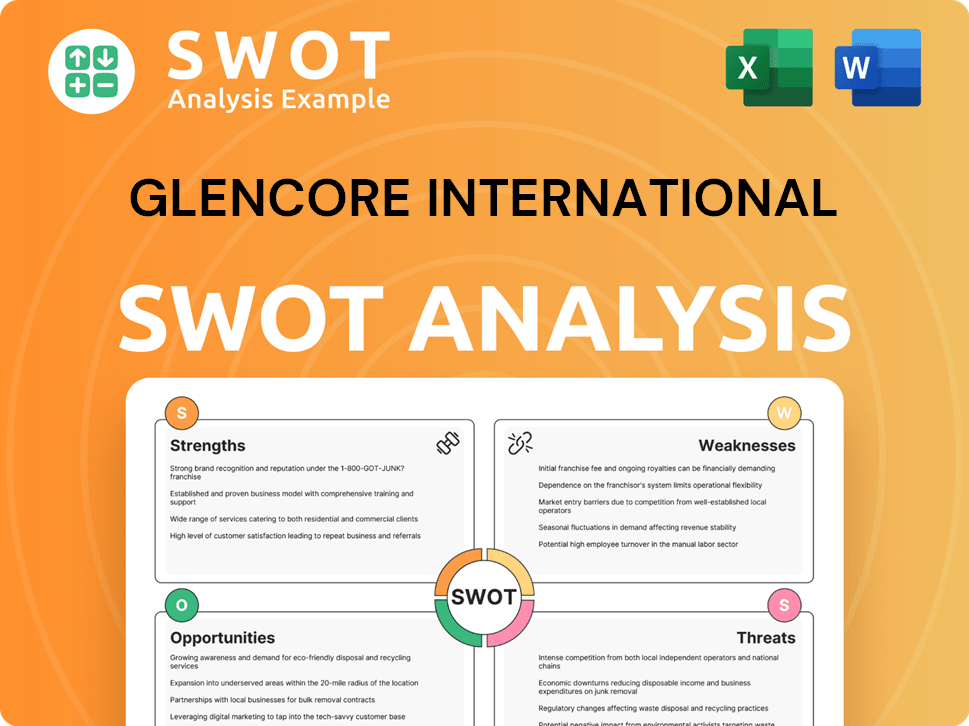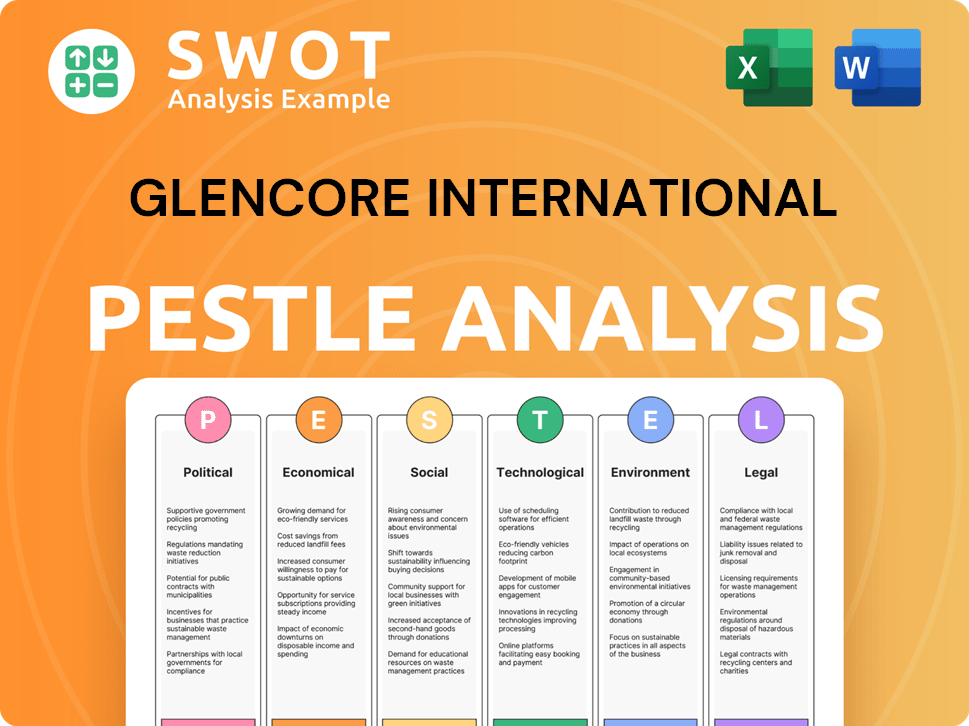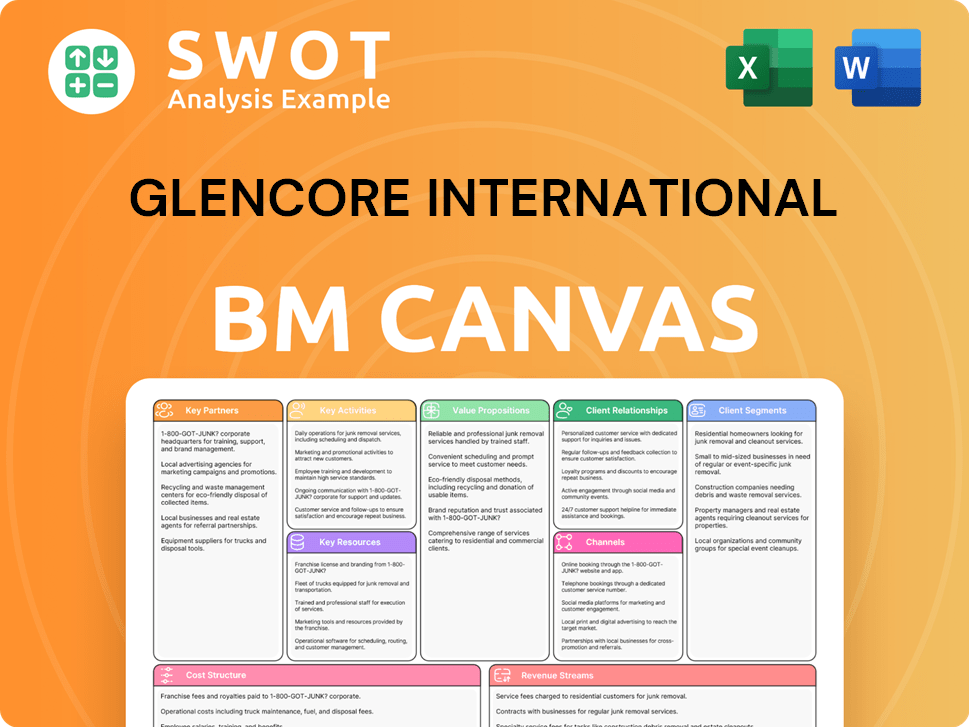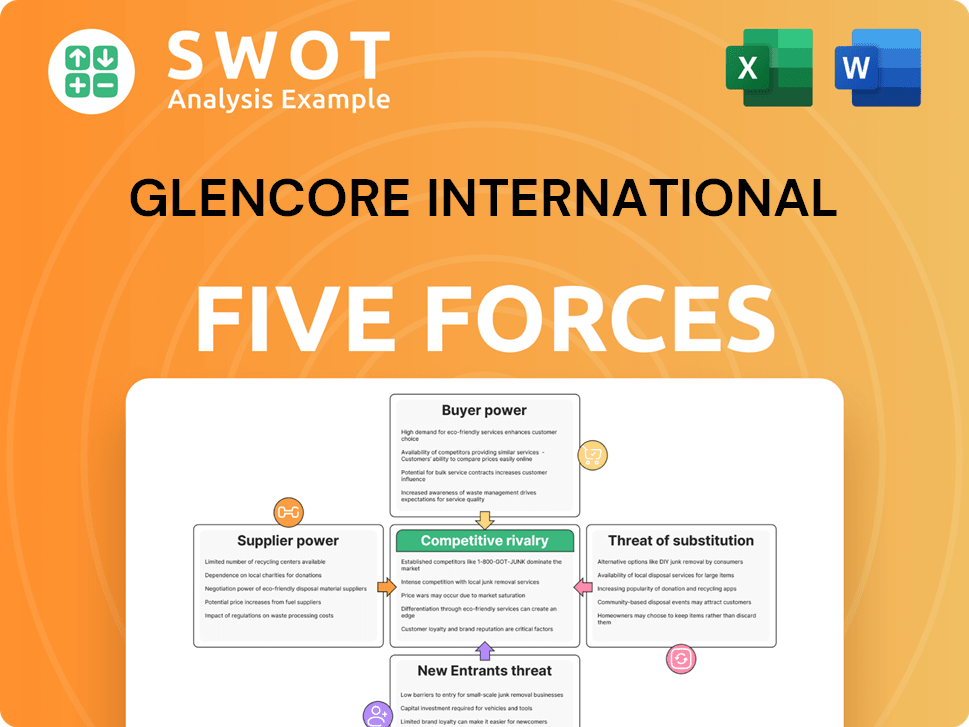Glencore International Bundle
Can Glencore Maintain Its Momentum?
Glencore International, a titan in commodities trading and mining, has a story that began in 1974, evolving from a trading house to a global powerhouse. Its 2013 merger with Xstrata was a game-changer, significantly boosting its mining assets and market position. This journey underscores the importance of a robust growth strategy within the volatile natural resources sector. This exploration will delve into how Glencore plans to achieve future growth through strategic expansion, innovation, and meticulous planning.

Understanding Glencore International SWOT Analysis is crucial for grasping its strategic positioning. The company's evolution from a niche player to a global leader in commodities trading and the mining industry highlights its adaptability. Examining Glencore's growth strategy analysis reveals how it navigates the complexities of the global economy, focusing on its future prospects and long-term sustainability.
How Is Glencore International Expanding Its Reach?
The expansion initiatives of Glencore are primarily geared towards optimizing its current asset base and strategically entering new markets. A significant portion of their strategy involves increasing the production of essential commodities for decarbonization, such as copper, nickel, and cobalt. This approach aligns with the growing global demand for materials critical to the energy transition.
Furthermore, Glencore actively seeks selective acquisitions and continuously evaluates its portfolio for the divestment of non-core assets. This helps streamline operations and reallocate capital towards higher-growth opportunities. Geographical expansion remains a key focus, with a strong emphasis on emerging markets that hold rich mineral deposits.
Sustainability and responsible sourcing are also central to Glencore's expansion strategy. Meeting stringent environmental, social, and governance (ESG) criteria is crucial for accessing capital and operating licenses. This commitment is vital for long-term growth and maintaining a positive impact on the environment and communities.
Glencore focuses on enhancing production at its existing mines through debottlenecking projects. For example, they are expanding copper production, a metal vital for electric vehicles and renewable energy technologies. These initiatives aim to maximize output and efficiency from current operations, ensuring sustainable growth.
The company is actively pursuing selective acquisitions to bolster its portfolio. This includes acquiring assets that complement existing operations and expand its presence in key commodity markets. Recent acquisitions have focused on assets that align with the energy transition and sustainable mining practices.
Glencore is exploring opportunities in emerging markets with significant mineral deposits, often forming partnerships to mitigate risks. This includes regions with high potential for copper, nickel, and cobalt, which are crucial for the energy transition. These strategic moves aim to diversify its geographical footprint.
Glencore prioritizes sustainability and responsible sourcing to meet stringent ESG criteria. This includes investing in technologies and practices that reduce environmental impact and promote social responsibility. These initiatives are crucial for securing operating licenses and accessing capital in new territories.
Glencore's expansion strategy is multifaceted, focusing on increasing production of critical metals, pursuing strategic acquisitions, and entering new markets. This approach is supported by a strong emphasis on sustainability and responsible sourcing, ensuring long-term growth and value creation. The company’s ability to adapt to market changes and meet ESG standards is crucial for its future prospects.
- Increasing production of copper, nickel, and cobalt to meet the demands of the energy transition.
- Strategic acquisitions to expand its asset portfolio and presence in key commodity markets.
- Entering new markets with significant mineral deposits, often through partnerships to mitigate risks.
- Prioritizing sustainability and responsible sourcing to meet ESG criteria and secure operating licenses.
Glencore International SWOT Analysis
- Complete SWOT Breakdown
- Fully Customizable
- Editable in Excel & Word
- Professional Formatting
- Investor-Ready Format

How Does Glencore International Invest in Innovation?
Glencore International actively integrates innovation and technology to boost operational efficiency, improve safety, and foster sustainable growth across its diverse portfolio. The company's commitment to technological advancement is evident in its investments in research and development, often collaborating with technology providers and academic institutions.
A key focus of Glencore's strategy is digital transformation, utilizing data analytics, artificial intelligence (AI), and machine learning to optimize mining processes, predict equipment failures, and improve resource utilization. These initiatives are crucial for maintaining a competitive edge in the dynamic commodities market. This approach not only enhances productivity but also aligns with the growing need for responsible resource management.
The company is also dedicated to reducing its environmental footprint through technological advancements, such as exploring carbon capture technologies and improving energy efficiency at its facilities. Glencore's innovation strategy extends to developing advanced recycling capabilities for critical metals, supporting the circular economy and securing future resource supply.
Glencore leverages data analytics and AI to optimize mining processes, predict equipment failures, and improve resource utilization, enhancing operational efficiency. This digital transformation is a core element of its growth strategy, helping to reduce costs and increase output.
Implementing automation in mining operations enhances productivity and reduces human exposure to hazardous environments. This approach not only improves safety but also contributes to Glencore's long-term sustainability goals, as the mining industry evolves.
Glencore is committed to reducing its environmental footprint through technological advancements, such as exploring carbon capture technologies and improving energy efficiency. These initiatives are crucial for navigating the energy transition and ensuring sustainable operations.
Developing advanced recycling capabilities for critical metals supports the circular economy and secures future resource supply. This strategy positions Glencore as a leader in responsible resource management and contributes to its long-term growth prospects.
Glencore invests significantly in research and development, often collaborating with technology providers and academic institutions. These investments are vital for developing cutting-edge solutions and maintaining a competitive advantage in the mining industry.
The integration of technology and innovation directly contributes to Glencore's growth objectives by reducing costs, increasing output, and positioning the company as a leader in responsible and technologically advanced resource extraction. These efforts are key to the future of Glencore in the commodities market.
These technological advancements contribute directly to Glencore's growth objectives by reducing costs, increasing output, and positioning the company as a leader in responsible and technologically advanced resource extraction. For a deeper understanding of Glencore's business model and revenue streams, consider reading about Revenue Streams & Business Model of Glencore International.
Glencore's focus on innovation and technology is multifaceted, encompassing digital transformation, automation, and environmental sustainability. These initiatives are designed to enhance operational efficiency and drive long-term growth.
- Data Analytics and AI: Used to optimize mining processes and predict equipment failures, improving overall efficiency.
- Automation: Implemented in mining operations to enhance productivity and reduce human exposure to hazardous environments.
- Carbon Capture Technologies: Exploring and implementing technologies to reduce the environmental footprint.
- Advanced Recycling: Developing capabilities for critical metals to support the circular economy and secure future resource supply.
Glencore International PESTLE Analysis
- Covers All 6 PESTLE Categories
- No Research Needed – Save Hours of Work
- Built by Experts, Trusted by Consultants
- Instant Download, Ready to Use
- 100% Editable, Fully Customizable

What Is Glencore International’s Growth Forecast?
The financial outlook for Glencore International is largely shaped by its diversified business model and strategic focus on commodities essential for the energy transition. The company's performance is closely linked to global commodity prices and demand, especially for metals like copper, nickel, and cobalt, which are crucial for electric vehicles and renewable energy infrastructure. Glencore's ability to navigate market cycles and maintain a strong financial position is key to its future success.
Glencore's growth strategy emphasizes disciplined capital allocation and a commitment to returning value to shareholders. The company aims to maintain a robust balance sheet while investing in projects that align with long-term commodity trends. This approach is designed to ensure sustained profitability and shareholder returns, even amidst the volatility inherent in the commodities market. The company's strategic plans are supported by its capacity to self-fund growth initiatives through strong operational cash flows.
For the full year 2023, Glencore reported an adjusted EBITDA of $17.1 billion, demonstrating the resilience of its diversified model despite the cyclical nature of commodity markets. This financial performance underscores the company's ability to generate substantial cash flow, which supports its strategic objectives. The company continues to focus on operational efficiencies and strategic investments to capitalize on opportunities in the mining industry and commodities trading.
Glencore's financial performance is a key indicator of its overall health and future prospects. The company's adjusted EBITDA of $17.1 billion for 2023 reflects its ability to generate substantial earnings even in fluctuating market conditions. This robust financial performance supports the company's strategic initiatives and shareholder returns.
Glencore's capital allocation strategy is designed to balance investments in growth with returns to shareholders. The company's disciplined approach ensures that it maintains a strong balance sheet while investing in projects that align with long-term commodity trends. This strategy is crucial for sustaining profitability and shareholder value.
Glencore reported a net debt of $4.9 billion in its 2023 annual report, indicating a healthy financial position. This strong balance sheet provides flexibility for the company to pursue strategic opportunities and navigate market volatility. A solid financial foundation is crucial for supporting Glencore's expansion plans and ensuring long-term sustainability.
Glencore is committed to returning capital to shareholders through dividends and share buybacks. This demonstrates the company's confidence in its future financial performance and its ability to generate significant free cash flow. Shareholder returns are a key component of Glencore's value proposition.
Analyst forecasts generally anticipate continued robust performance, driven by favorable long-term commodity price trends and Glencore's operational efficiencies. The company's strategic focus on commodities essential for the energy transition positions it well for future growth. Glencore's ability to self-fund growth initiatives through strong operational cash flows further supports its financial outlook. To understand more about the company's early days, consider reading the Brief History of Glencore International.
The increasing demand for copper, nickel, and cobalt, driven by the energy transition, is a significant factor in Glencore's future prospects. These metals are essential for electric vehicles and renewable energy infrastructure. Glencore's focus on these commodities positions it favorably in the market.
Glencore's operational efficiencies play a crucial role in its financial performance. By optimizing its operations, the company can enhance profitability and maintain a competitive edge in the mining industry and commodities trading. These efficiencies contribute to the company's overall financial health.
Strategic investments in projects aligned with long-term commodity trends are essential for Glencore's growth strategy. These investments support the company's ability to capitalize on market opportunities and drive future revenue streams. The company's focus on strategic investments is key to its long-term success.
Glencore's market capitalization reflects its overall value and investor confidence. The company's market capitalization is a key indicator of its financial health and future prospects. It is influenced by factors such as commodity prices, operational performance, and strategic decisions.
Glencore's competitive advantage stems from its diversified portfolio, operational efficiencies, and strategic investments. These factors enable the company to navigate market cycles and maintain a strong financial position. Glencore's competitive advantage is essential for its long-term sustainability.
Glencore's expansion plans are supported by its strong financial position and access to capital markets. The company is focused on strategic growth initiatives that align with long-term commodity trends. These expansion plans are crucial for increasing Glencore's market share.
Glencore International Business Model Canvas
- Complete 9-Block Business Model Canvas
- Effortlessly Communicate Your Business Strategy
- Investor-Ready BMC Format
- 100% Editable and Customizable
- Clear and Structured Layout

What Risks Could Slow Glencore International’s Growth?
The Glencore faces various risks that could influence its growth strategy and future prospects within the commodities market. These challenges are inherent in the volatile global commodity industry, which requires careful management to ensure sustained performance. Understanding these risks is essential for investors and stakeholders assessing the long-term viability of Glencore International.
Market competition, regulatory changes, and supply chain vulnerabilities are significant obstacles. Technological disruption and internal resource constraints also pose threats. Glencore must continually adapt and innovate to navigate these challenges successfully. The company's ability to mitigate these risks will determine its success in the future.
Glencore's risk management framework includes diversification, scenario planning, and stakeholder engagement to address potential issues. The company's proactive approach to compliance and governance demonstrates its commitment to overcoming obstacles. Emerging risks, such as increased scrutiny on ESG performance and resource nationalism, will shape its future trajectory.
Intense competition from other major miners and trading houses impacts Glencore's market share. These competitors vie for resources and market dominance, creating pressure on pricing and profitability. This rivalry requires Glencore to continually seek operational efficiencies and strategic advantages.
Changes in environmental protection, labor laws, and taxation pose ongoing challenges. These regulations can increase operational costs and influence investment decisions. Glencore must adapt to these evolving regulatory landscapes to maintain compliance and operational efficiency.
Geopolitical instability, logistical disruptions, and natural disasters can disrupt commodity production and delivery. These vulnerabilities can lead to delays, increased costs, and reduced revenues. Glencore needs robust supply chain management to mitigate these risks effectively.
Failure to adapt to new mining techniques or processing technologies can be a risk. Competitors' innovations can create a competitive disadvantage. Glencore must invest in research and development and embrace technological advancements to stay competitive.
Shortages of skilled labor or capital allocation challenges can hinder expansion projects. Efficient resource management is vital for supporting Glencore's growth strategy. Addressing these constraints is crucial for achieving its expansion goals.
Increased scrutiny on ESG performance and the potential for resource nationalism will continue to shape Glencore's future. These emerging risks require proactive measures. Glencore must demonstrate its commitment to sustainability and responsible resource management to mitigate these risks.
Glencore employs a comprehensive risk management framework. This includes diversification across commodities and geographies to reduce exposure to single markets. Robust scenario planning helps the company prepare for various potential challenges. Proactive engagement with stakeholders ensures alignment and addresses concerns effectively.
Glencore has actively worked to address past compliance issues, demonstrating its commitment to overcoming regulatory obstacles. Improving its governance structure is a key priority. This commitment enhances its reputation and strengthens its ability to operate in a complex global environment.
Glencore International Porter's Five Forces Analysis
- Covers All 5 Competitive Forces in Detail
- Structured for Consultants, Students, and Founders
- 100% Editable in Microsoft Word & Excel
- Instant Digital Download – Use Immediately
- Compatible with Mac & PC – Fully Unlocked

Related Blogs
- What are Mission Vision & Core Values of Glencore International Company?
- What is Competitive Landscape of Glencore International Company?
- How Does Glencore International Company Work?
- What is Sales and Marketing Strategy of Glencore International Company?
- What is Brief History of Glencore International Company?
- Who Owns Glencore International Company?
- What is Customer Demographics and Target Market of Glencore International Company?
Disclaimer
All information, articles, and product details provided on this website are for general informational and educational purposes only. We do not claim any ownership over, nor do we intend to infringe upon, any trademarks, copyrights, logos, brand names, or other intellectual property mentioned or depicted on this site. Such intellectual property remains the property of its respective owners, and any references here are made solely for identification or informational purposes, without implying any affiliation, endorsement, or partnership.
We make no representations or warranties, express or implied, regarding the accuracy, completeness, or suitability of any content or products presented. Nothing on this website should be construed as legal, tax, investment, financial, medical, or other professional advice. In addition, no part of this site—including articles or product references—constitutes a solicitation, recommendation, endorsement, advertisement, or offer to buy or sell any securities, franchises, or other financial instruments, particularly in jurisdictions where such activity would be unlawful.
All content is of a general nature and may not address the specific circumstances of any individual or entity. It is not a substitute for professional advice or services. Any actions you take based on the information provided here are strictly at your own risk. You accept full responsibility for any decisions or outcomes arising from your use of this website and agree to release us from any liability in connection with your use of, or reliance upon, the content or products found herein.